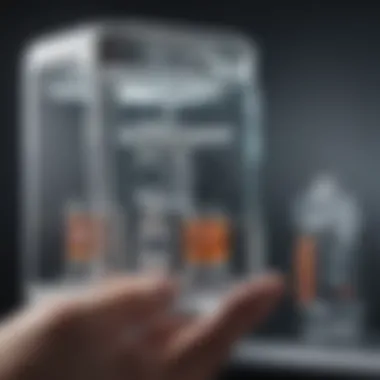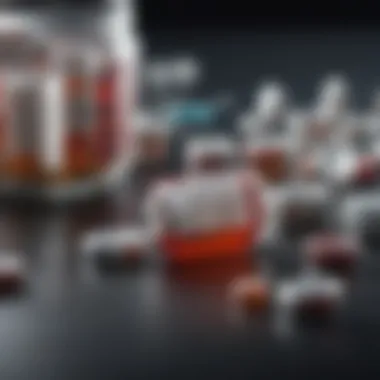Innovations in Medication Delivery Devices


Overview of Research Topic
Brief Background and Context
Medication delivery devices serve as crucial instruments in the realm of healthcare, providing essential support for the administration of various therapeutic substances. Traditionally, methods like syringes and pills offered straightforward options, but the evolution of technology has ushered in a new generation of devices. Innovations such as smart inhalers, wearable patches, and implantable devices are transforming how patients receive medication. These advancements reflect not only improvements in design but also significant enhancements in efficacy, with many designed to meet the unique needs of diverse patient populations.
Importance in Current Scientific Landscape
In a world where patient compliance is pivotal to treatment success, understanding the innovations in medication delivery devices is more crucial than ever. These devices influence not only the pharmacokinetics of medications but also the overall experience and management of patient health. The implications extend beyond individual treatment plans; they affect public health outcomes and healthcare systems at large. As we explore these developments, the integration of technology into medication delivery highlights critical intersections of healthcare, patient-centered design, and regulatory challenges.
"Modern medication delivery innovations have the potential to fundamentally alter the patient experience, enhancing adherence and therapeutic outcomes."
Methodology
Research Design and Approach
This article employs a qualitative research design to examine the innovations in medication delivery devices. By reviewing existing literature, interviews with healthcare professionals, and analyses of case studies, we gather insights into both the historical context and contemporary developments in this field. The multidimensional approach allows for a richer understanding of the innovations and their impacts on healthcare practices.
Data Collection Techniques
Data was collected through various techniques to ensure a comprehensive view:
- Literature Review: Examining peer-reviewed articles and recent publications on medication delivery technologies.
- Interviews: Conducting discussions with healthcare providers to obtain firsthand accounts of device integration in patient care.
- Case Studies: Analyzing specific implementations of new medication delivery systems to observe real-world results.
These methods collectively inform the discussion on current and future trends in medication delivery devices, highlighting both the benefits and challenges faced in this dynamic area of healthcare.
Preamble to Medication Delivery Devices
Medication delivery devices play a pivotal role in modern healthcare, facilitating the effective administration of therapeutic agents. Their significance lies in their ability to enhance patient outcomes, improve adherence to treatment regimens, and provide safe options for medication delivery. With the increasing complexity of patient needs and the rise of chronic diseases, these devices have evolved to suit various applications. Understanding these devices is crucial within the broader scope of healthcare, as they directly impact patient management and overall health experience.
Definition and Importance
Medication delivery devices refer to specialized instruments that administer medication in various forms, including injectable, inhalation, transdermal, and oral delivery systems. These devices bridge the gap between pharmaceuticals and patient compliance. The importance of these devices cannot be overstated—they improve precision in medication administration, reduce the risk of misuse, and cater to diverse patient needs.
The development of new technologies in this field aligns with the objective to enhance therapeutic outcomes. In addition, they are designed with features that promote usability and comfort, such as smart devices that can connect to mobile applications for monitoring purposes. This technology fosters communication between patients and healthcare providers, allowing for real-time feedback on treatment adherence.
Historical Overview
The evolution of medication delivery devices traces back to early medical practices. Ancient civilizations utilized rudimentary methods to administer medicine, ranging from herbal poultices to simple syringes made from animal bladders. The modern era saw substantial advancements in the late 19th and early 20th centuries with the introduction of hypodermic needles and glass syringes.
The development of prefilled syringes and auto-injectors further revolutionized this field, providing healthcare professionals and patients with efficient and safe methods of administration. The late 20th century introduced inhalers and nebulizers, which became essential in treating respiratory conditions.
Current advancements lean heavily on technology, with innovations such as smart inhalers and automated delivery systems addressing complex treatment regimens. These advancements not only reflect technological progress but also a deeper understanding of patient needs. By reviewing the historical context, we can appreciate how far medication delivery devices have come and how they will continue to evolve to meet future healthcare challenges.
Types of Medication Delivery Devices
The significance of Medication Delivery Devices is rooted in their ability to ensure effective treatment through various methods of administration. They enhance patient adherence and optimize therapeutic outcomes. With advancements in technology, the variety of these devices has expanded, making them accessible for different needs. Understanding the types of devices available aids healthcare professionals in selecting appropriate solutions for patient care.
Injectable Devices
Injectable devices represent a primary category within medication delivery, catering to both acute and chronic conditions. They allow for precise dosing and quick delivery of medication into the bloodstream.


Prefilled Syringes
Prefilled syringes are a practical innovation in medication delivery. These devices come pre-loaded with a specific volume of medication, ensuring accuracy in dosing. One of the key characteristics of prefilled syringes is their convenience of use. Patients or healthcare providers can administer injections without the need for preparation. A unique feature is their design to enhance safety, typically incorporating mechanisms that prevent needle-stick injuries. The advantages of prefilled syringes include ease of use and reduced risk of contamination. However, potential disadvantages may involve limited refill options and the necessity for proper disposal.
Auto-Injectors
Auto-injectors are another important form of injectable devices. They provide an automated method for injecting medication. They are especially beneficial for self-administration in emergencies, such as anaphylactic reactions. A notable characteristic of auto-injectors is their user-friendly design, making them accessible to patients without medical training. Their unique feature is the integration of safety mechanisms, which minimize user error during administration. While auto-injectors offer significant advantages like portability and ease of use, they can also present disadvantages, such as higher costs and the necessity for precise instructions.
Microneedles
Microneedles represent a more recent development in injectable devices, offering a minimally invasive option. These devices consist of tiny needles that penetrate the outer layer of the skin, delivering medication without causing significant pain. A key characteristic of microneedles is their potential to reduce discomfort and fear associated with injections. They can be manufactured in various forms, including dissolvable or coated with medication. This unique feature allows controlled delivery of vaccines or drugs. The benefits of microneedles include improved patient compliance and increased safety. Nevertheless, challenges exist in terms of manufacturing scalability and regulatory approval.
Inhalation Devices
Inhalation devices cater to patients needing respiratory treatments. They provide efficient direct delivery of medication to the lungs, which can enhance drug efficacy and reduce systemic side effects.
Inhalers
Inhalers are the most common inhalation devices. They allow for the direct administration of medication into the respiratory tract, making them essential tools for managing asthma and chronic obstructive pulmonary disease (COPD). A pivotal characteristic of inhalers is their ability to deliver medication in a vaporized form, which facilitates quick absorption. Their design often incorporates a metered-dose mechanism, ensuring the patient receives the correct amount of medication. Benefits include ease of use and portability. However, the disadvantages may include difficulties in technique that can affect drug delivery.
Nebulizers
Nebulizers are devices that convert liquid medication into a mist for inhalation. They offer a viable alternative for patients unable to use inhalers effectively. The defining characteristic of nebulizers is their ability to deliver medication over extended periods, which can be particularly beneficial in acute situations. The unique feature is the wide variety of medications that can be delivered, making them suitable for children and others with specific needs. While nebulizers improve accessibility, they can be bulky and less portable compared to inhalers.
Dry Powder Inhalers
Dry powder inhalers are designed to dispense medication in a powdered form. They require the patient to generate a strong inhalation effort to receive the full dose of medication. A key characteristic of these devices is their breath-actuated design, which optimizes medication delivery efficiency. The unique aspect of dry powder inhalers is the lack of propellant, which can be an advantage for patients sensitive to inhaler propellants. Their benefits include simplicity in design and portability. However, the requirement for a specific inhalation technique can be a disadvantage.
Transdermal Devices
Transdermal devices allow for the continuous delivery of medication through the skin. This method can help maintain steady drug levels in the bloodstream, enhancing patient comfort and compliance.
Transdermal Patches
Transdermal patches are adhesive patches applied to the skin. These devices deliver medication over a specific period. A significant characteristic of transdermal patches is their ability to provide sustained release of medication, which can be advantageous for chronic pain management. Their unique feature is the simplicity of administration, allowing for once-daily applications. Benefits include improved patient adherence and decreased side effects. Some disadvantages include skin irritation and the potential for variable absorption rates based on individual skin characteristics.
Microneedle Arrays
Microneedle arrays are an advanced class of transdermal devices featuring an array of tiny needles that create microchannels in the skin. They enable efficient drug delivery while minimizing pain. The primary characteristic of microneedle arrays is their ability to increase the permeability of the skin to medications. Their unique feature is facilitating vaccine delivery without the discomfort of conventional needles. The advantages include enhanced patient comfort and the potential for self-administration. Challenges may include manufacturing complexity and ensuring stability of the drugs.
Oral Delivery Systems
Oral delivery systems are commonly used due to their convenience. They facilitate patient compliance and are often the preferred method for medication administration.
Smart Pill Bottles
Smart pill bottles are an innovative advancement in oral delivery systems. They are designed to aid medication adherence by reminding patients when to take their medication. A key characteristic of smart pill bottles is their integration with mobile applications for monitoring usage. They help tackle the common issue of non-compliance. The unique feature of these devices is data tracking, allowing healthcare providers to monitor adherence closely. Benefits include improved management of chronic conditions. However, potential disadvantages are related to technology dependency and cybersecurity risks.
Drug-Embedded Biomaterials
Drug-embedded biomaterials represent a novel approach to oral medication delivery. These materials are designed to release drugs gradually in the gastrointestinal tract. A main characteristic of this technology is its ability to control the release rate of medications. Unique features include the customization of release profiles according to patient needs. The advantages of drug-embedded biomaterials include targeted delivery and reduced side effects. Nevertheless, the challenges may relate to regulatory approval processes and product manufacturing.


Technological Innovations
Technological innovations in medication delivery devices represent a significant leap in enhancing patient care and treatment efficacy. The integration of advanced technologies has paved the way for smarter, more intuitive devices that improve medication adherence and minimize errors. These innovations can potentially transform how patients interact with their treatment regimens, leading to better health outcomes. Understanding this aspect is crucial for recognizing the future directions in healthcare practices.
Smart Devices
Smart devices have revolutionized the landscape of medication delivery. They use digital technologies to stream information and ensure effective therapeutic outcomes. These devices not just provide the medication but also include features that help in tracking and managing drug delivery. The rise of connectivity in healthcare devices has become an integral part of modern medicine.
Mobile Health Applications
Mobile health applications serve as a key element of smart devices. They allow users to monitor their health and medication adherence from their smartphones. One major characteristic of these applications is their accessibility. Users can easily download them, making it a convenient choice for many. Their unique feature is the ability to provide reminders for medication intake, ensuring timely doses.
Advantages of mobile health applications include their role in empowering patients to take charge of their health. However, they can also have disadvantages, such as dependency on technology and potential privacy concerns regarding user data. In the broader context, mobile health applications significantly contribute to medication management and adherence outcomes.
Wireless Monitoring
Wireless monitoring represents another pivotal innovation in the context of smart devices. It allows healthcare practitioners to track patient data continuously. This is especially crucial for chronic disease management, providing real-time insights into a patient’s adherence to medication. One key characteristic of wireless monitoring is its real-time data collection, which helps in proactive health management.
The unique feature of these devices is their ability to transmit patient data to healthcare providers automatically. This can lead to timely interventions when issues arise. However, disadvantages can include reliance on stable internet connectivity and potential data security concerns. Overall, wireless monitoring enhances patient safety and promotes better health management practices.
Biocompatible Materials
Biocompatible materials are essential for the safety and effectiveness of medical devices. These materials minimize complications when used in the human body, ensuring that devices do not elicit adverse reactions. Their importance cannot be overstated, as the wrong material could lead to severe complications or device failure. This section will explore innovations in biocompatible materials and their impacts on medication delivery systems.
Controlled Release Systems
Controlled release systems are designed to deliver medication in a predictable manner over a specified period. This capability is crucial for maintaining therapeutic levels of drugs in the bloodstream, leading to improved patient compliance and reduced side effects. By facilitating a consistent release of medication, these systems allow for less frequent dosing, which can be a significant advantage for patients who struggle with regular medication schedules.
Regulatory Considerations
Regulatory considerations are critical in the realm of medication delivery devices. These frameworks ensure that devices are developed, tested, and used effectively while prioritizing patient safety. They address multiple aspects, including design quality, manufacturing processes, and clinical efficacy. Ensuring compliance with established regulations helps to minimize risks associated with device malfunction, inadequate delivery systems, and overall patient exposure to harmful practices.
The importance of these regulations cannot be overstated. They play a vital role in fostering innovation by providing a structured pathway for developers. With clear guidelines, researchers can create groundbreaking technologies that enhance patient care. Effective regulation also builds trust among patients and healthcare professionals, reassuring them about the safety and effectiveness of the devices they use.
FDA Regulations
The Food and Drug Administration (FDA) oversees the regulatory framework for medication delivery devices in the United States. The FDA categorizes these devices based on their risk levels, with Class I devices being the least risky and Class III the highest. This classification determines the type of premarket submission required. For instance, Class I devices may require only general controls, while Class III devices necessitate rigorous premarket approval.
Approval from the FDA is essential. This process verifies that devices meet safety and efficacy standards before reaching patients. One vital aspect of FDA regulations is the requirement for post-market surveillance. This ensures that data on device performance continues to be collected even after approval, allowing for prompt action should safety issues arise. Overall, FDA regulations are a cornerstone of device validation, providing a comprehensive approach to guarantee that medication delivery devices serve their intended purpose without risking patient safety.
International Guidelines
International guidelines exist to harmonize regulations across different countries. Organizations like the World Health Organization (WHO) and the International Organization for Standardization (ISO) develop these standards. These bodies aim to ensure that medication delivery devices are safe for use worldwide, regardless of location.
Adopting international standards can facilitate smoother international trade. It allows manufacturers to approach multiple markets equipped with a shared understanding of device efficacy and safety. This globalization helps to harmonize best practices, making it easier for nations to rely on each other’s regulatory frameworks.
In summary, regulatory considerations significantly influence the field of medication delivery devices. The stringent processes put in place by the FDA and international bodies uphold a standard that protects patients and advances technology. As the landscape of healthcare evolves, these regulations will remain pivotal in guiding innovation.
Challenges in Medication Delivery
Medication delivery devices, while offering numerous benefits, also face significant challenges that affect both their efficacy and the outcomes of patient treatment. Understanding these challenges is crucial for improving healthcare practices. This section focuses on patient compliance issues and device failure risks, two key elements that directly impact the success of these devices in real-world settings.


Patient Compliance Issues
Patient compliance, or adherence, to prescribed medication regimens is a pervasive issue in healthcare. Research indicates that nearly 50% of patients do not take medicines as prescribed. There are various reasons for this non-compliance, and they vary from patient to patient.
- Complexity of Regimens: Many patients face complex medication schedules. For instance, some therapies may require multiple medications at different times. This complexity can lead to confusion and undermine adherence.
- Side Effects: Side effects can deter patients from continuing their medication. If a device, such as an auto-injector, causes discomfort or has unpleasant side effects, the patient might stop using it altogether.
- Lack of Understanding: Sometimes patients do not fully understand how to use a device. For example, inhalers may not be used correctly, leading to ineffectiveness. Clear instructions and education can mitigate this.
- Psychological Factors: Mental health issues, such as depression or anxiety, can also adversely affect a patient's ability to comply with treatment. Addressing psychological barriers is equally essential as addressing physical barriers.
The implications of non-compliance are serious, leading to poor health outcomes, increased hospitalizations, and higher healthcare costs. Therefore, healthcare professionals must prioritize strategies that enhance patient understanding and engagement.
Device Failure Risks
Device failure is another critical concern that can adversely impact medication delivery effectiveness. The functionality and reliability of devices are paramount. If a device fails, it can result in inadequate medication delivery.
- Manufacturing Defects: Occasionally, devices may have defects that make them inoperable. For example, prefilled syringes may leak or clog, rendering them useless.
- User Error: Incorrect use of a device is a prevalent issue that can lead to failure. Users may not follow the proper procedure, leading to incorrect dosages or no delivery at all.
- Environmental Factors: Certain devices can be sensitive to temperature, humidity, or physical stress. Exposure to extreme conditions might degrade the system. Thus, packaging and storage are just as important as construction.
- Aging Devices: Over time, devices may wear down. Regular maintenance checks and replacements are vital to ensure continued functionality.
Effective management of device failure risks requires robust quality assurance practices and ongoing user education.
Overall, addressing challenges in medication delivery is essential for improving patient outcomes. Healthcare providers, researchers, and technologists must work collaboratively to craft solutions that enhance compliance and reduce device failures. This focus is not only critical for patient management but is also central to the advancement of medication delivery technologies.
Future Directions
The future directions of medication delivery devices present pivotal opportunities and significant challenges in the evolving landscape of medical technology. These advancements promise enhancements in efficacy and patient experience, ensuring medical solutions are both effective and user-friendly. In this era of rapid technological change, understanding emerging technologies and personalized medicine is crucial.
Emerging Technologies
Emerging technologies in medication delivery devices focus on innovations that improve the convenience and precision of treatments. New developments include nanotechnology, which offers opportunities for drug encapsulation and targeted delivery. These techniques can maximize therapeutic efficacy while minimizing side effects. Additionally, 3D printing has gained traction in creating customized medications tailored to individual patient needs.
Some notable aspects of emerging technologies are:
- Microneedle technology: Minimizes pain and enhances drug delivery through patches that penetrate the skin without causing significant discomfort.
- Smart inhalers: Equipped with sensors that track usage and send data to mobile applications, helping patients adhere to medication schedules.
- Wearable devices: These can monitor health metrics and administer medication in real time, thus personalizing treatment based on patient data.
As these technologies become more accessible, they will likely transform current practices in medication administration, making treatments more effective and aligning them with patient lifestyles.
Personalized Medicine
Personalized medicine continues to reshape the approach to treatment and medication delivery. This paradigm shift emphasizes the customization of healthcare, tailoring therapy based on individual characteristics, genetics, and environmental factors.
The implications of personalized medicine for medication delivery devices are profound. A few critical points include:
- Tailored formulations: Medications can now be developed to suit the unique genetic profiles of patients, potentially increasing effectiveness and reducing side effects.
- Adaptive delivery systems: Devices that adapt dosages based on real-time feedback from the patient’s body can optimize treatment outcomes significantly.
- Patient engagement: Personalized medicine enhances patient understanding and involvement in their treatment plans, leading to better compliance and satisfaction.
"Personalized medicine holds the potential to revolutionize the patient experience by delivering treatment that truly fits the individual."
Ending
Understanding medication delivery devices is crucial in today's healthcare landscape. This article highlights the significance of these devices by exploring their innovations, challenges, and impacts on patient management.
Summary of Key Points
The article covers several essential elements:
- Types of Devices: We examined various medication delivery devices, including injectables, inhalation devices, transdermal systems, and oral delivery methods. Each type demonstrates unique characteristics and applications in patient care.
- Technological Innovations: Advancements like smart devices and controlled release systems are reshaping how medications are administered and monitored. This evolution enhances therapeutic outcomes while ensuring better patient compliance.
- Regulatory Landscape: Analyzing FDA regulations and international guidelines provided insight into the necessary framework that governs the development and usage of these devices.
- Challenges: Issues of patient compliance and device failure must be addressed to optimize the delivery and efficacy of medications.
- Future Directions: Emerging technologies and personalized medicine will further define the future of medication delivery, emphasizing the need for continuous innovation in this field.
The Role of Medication Delivery Devices in Healthcare
Medication delivery devices significantly impact healthcare by improving how patients receive treatments. Their role varies from enhancing medication adherence to facilitating accurate dosing. These devices ensure the right drug is delivered at the right time and in the correct manner, reducing the risk of errors.
Moreover, with the rise of chronic diseases, tailored medication delivery systems are essential. They can adapt to changing patient needs, ensuring that therapies remain effective over time. Integrating technology means these devices can also provide real-time data, empowering both healthcare professionals and patients.



